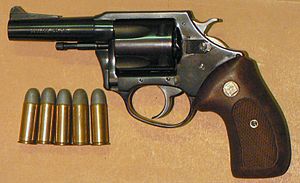.44 S&W Special
| .44 Special | ||||||||||||
|---|---|---|---|---|---|---|---|---|---|---|---|---|

Charter Arms Bulldog with five .44 Special 246 gr LRN cartridges
|
||||||||||||
| Type | Revolver | |||||||||||
| Place of origin | United States | |||||||||||
| Production history | ||||||||||||
| Designer | Smith & Wesson | |||||||||||
| Designed | 1907 | |||||||||||
| Manufacturer | Smith & Wesson | |||||||||||
| Produced | 1907– | |||||||||||
| Specifications | ||||||||||||
| Parent case | .44 Russian | |||||||||||
| Bullet diameter | .4325 in (10.99 mm) | |||||||||||
| Neck diameter | .457 in (11.6 mm) | |||||||||||
| Base diameter | .457 in (11.6 mm) | |||||||||||
| Rim diameter | .514 in (13.1 mm) | |||||||||||
| Rim thickness | .060 in (1.5 mm) | |||||||||||
| Case length | 1.16 in (29 mm) | |||||||||||
| Overall length | 1.615 in (41.0 mm) | |||||||||||
| Case capacity | 33.4 gr H2O (2.16 cm3) | |||||||||||
| Rifling twist | 1 in 20 in (510 mm) | |||||||||||
| Primer type | Large pistol | |||||||||||
| Maximum pressure | 15,500 psi (107 MPa) | |||||||||||
| Ballistic performance | ||||||||||||
|
||||||||||||
|
Test barrel length: 4 in (vented) ¹ / 6 in ² Source(s): Federal Cartridge Co. Remington Arms Co. |
||||||||||||
The .44 Special or .44 S&W Special is a smokeless powder center fire metallic cartridge developed by Smith & Wesson in 1907 as the standard chambering for their New Century revolver, introduced in 1908.
On the late 19th Century American frontier, large .44- and .45-caliber cartridges were considered the epitome of handgun ammunition for self-protection and hunting. Black-powder rounds such as the .44 American, .44 Russian, .44-40 Winchester, and .45 Colt enjoyed a well-earned reputation for effective terminal ballistics, accuracy, and reliability.
At the start of the 20th Century, Smith & Wesson decided to celebrate by introducing a brand new revolver design which they called the New Century.
Smith & Wesson wished to pair their new revolver design with a worthy new ammunition chambering. At the time, smokeless powder was state of the art in ammunition technology. Older black-powder ammunition was in the process of being converted to smokeless. Smith & Wesson's popular .44 Russian cartridge had established a reputation for superb accuracy and was a renowned target load, and they decided to use an improved smokeless powder version as the basis for the new round. Due to the lower energy density of the early semi-smokeless powders, prior efforts to convert the .44 Russian to smokeless had produced less than stellar ballistic performance. Smith & Wesson addressed this issue by lengthening the .44 Russian cartridge case by 0.190-inch (4.8 mm) and increasing the powder capacity by 6 grains (0.39 g). The resulting design, which S&W called the .44 Special, had a case length of 1.16-inch (29 mm).
...
Wikipedia
